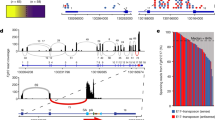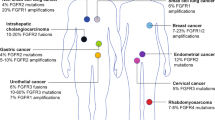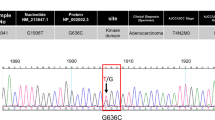Abstract
FGFRs (fibroblast growth factor receptors) are encoded by four genes (FGFR1 – 4). Alternative splicing results in various receptor isoforms. The FGFR2-IIIb variant is present in a wide variety of epithelia, including the bladder epithelium. Recently, we have shown that FGFR2-IIIb is downregulated in a subset of transitional cell carcinomas of the bladder, and that this downregulation is associated with a poor prognosis. We investigated possible tumour suppressive properties of FGFR2-IIIb by transfecting two human bladder tumour cell lines, J82 and T24, which have no endogenous FGFR2-IIIb expression, with FGFR2-IIIb cDNA. No stable clones expressing FGFR2-IIIb were isolated with the J82 cell line. For the T24 cell line, stable transfectants expressing FGFR2-IIIb had reduced growth in vitro and formed fewer tumours in nude mice which, in addition, grew more slowly. The potential mechanisms leading to decreased FGFR2-IIIb mRNA levels were also investigated. The 5′ region of the human FGFR2 gene was isolated and found to contain a CpG island which was partially methylated in more than half the cell lines and tumours which do not express FGFR2-IIIb. No homozygous deletion was identified in any of the tumours or cell lines with reduced levels of FGFR2-IIIb. Mutational analysis of the entire coding region of FGFR2-IIIb at the transcript level was performed in 33 bladder tumours. In addition to normal FGFR2-IIIb mRNA, abnormal transcripts were detected in two tumour samples. These abnormal mRNAs resulted from exon skipping which affected the region encoding the kinase domain. Altogether, these results show that FGFR2-IIIb has tumour growth suppressive properties in bladder carcinomas and suggest possible mechanisms of FGFR2 gene inactivation.
This is a preview of subscription content, access via your institution
Access options
Subscribe to this journal
Receive 50 print issues and online access
$259.00 per year
only $5.18 per issue
Buy this article
- Purchase on Springer Link
- Instant access to full article PDF
Prices may be subject to local taxes which are calculated during checkout






Similar content being viewed by others
Abbreviations
- FGFR2-IIIb:
-
fibroblast growth factor receptor 2-IIIb
- PCR:
-
polymerase chain reaction
References
Aaronson SA. . 1991 Science 254: 1146–1153.
Ahomadegbe JC, Barrois M, Fogel S, Le Bihan ML, Douc-Rasy S, Duvillard P, Armand JP and Riou G. . 1995 Oncogene 10: 1217–1227.
Avivi A, Skorecki K, Yayon A and Givol D. . 1992 Oncogene 7: 1957–1962.
Becker D, Meier CB and Herlyn M. . 1989 EMBO J. 8: 3685–3691.
Cappellen D, Gil Diez de Medina S, Chopin D, Thiery JP and Radvanyi F. . 1997 Oncogene 14: 3059–3066.
Carstens RP, Eaton JV, Krigman HR, Walther PJ and Garcia-Blanco MA. . 1997 Oncogene 15: 3059–3065.
Chesi M, Nardini E, Brents LA, Schrock E, Ried T, Kuehl WM and Bergsagel PL. . 1997 Nature Genet. 16: 260–264.
Colvin JS, Bohne BA, Harding GW, McEwen DG and Ornitz DM. . 1996 Nature Genet. 12: 390–397.
Cross M and Dexter TM. . 1991 Cell 64: 271–280.
Dell KR and Williams LT. . 1992 J. Biol. Chem. 267: 21225–21229.
De Moerlooze L and Dickson C. . 1997 Curr. Opin. Genet. Dev. 7: 378–385.
Deng C, Wynshaw-Boris A, Zhou F, Kuo A and Leder P. . 1996 Cell 84: 911–921.
Feng S, Wang F, Matsubara A, Kan M and McKeehan WL. . 1997 Cancer Res. 57: 5369–5378.
Fenig E, Wieder R, Paglin S, Wang H, Persaud R, Haimovitz-Friedman A, Fuks Z and Yahalom J. . 1997 Clin. Cancer Res. 3: 135–142.
Finch PW, Rubin JS, Miki T, Ron D and Aaronson SA. . 1989 Science 245: 752–755.
Gil Diez de Medina S, Chopin D, El Marjou A, Delouvée A, La Rochelle WJ, Hoznek A, Abbou C, Aaronson SA, Thiery JP and Radvanyi F. . 1997 Oncogene 14: 323–330.
Gil Diez de Medina S, Popov Z, Chopin DK, Southgate J, Tucker GC, Delouvée A, Thiery JP and Radvanyi F. . 1999 Oncogene in press.
Giroldi LA, Bringuier PP and Schalken JA. . 1994 Invasion Metastasis 14: 71–81.
Green PJ, Walsh FS and Doherty P. . 1996 Bioessays 18: 639–646.
Guilford P, Hopkins J, Harraway J, McLeod M, McLeod N, Harawira P, Taite H, Scoular R, Miller A and Reeve AE. . 1998 Nature 392: 402–405.
Haber D and Harlow E. . 1997 Nature Genet. 16: 320–322.
Halaban R, Ghosh S and Baird A. . 1987 In Vitro Cell. Dev. Biol. 23: 47–52.
Halaban R, Kwon BS, Ghosh S, Delli Bovi P and Baird A. . 1988 Oncogene Res. 3: 177–186.
Hattori Y, Odagiri H, Nakatani H, Miyagawa K, Naito K, Sakamoto H, Katoh O, Yoshida T, Sugimura T and Terada M. . 1990 Proc. Natl. Acad. Sci. USA 87: 5983–5987.
Ishiwata T, Friess H, Buchler MW, Lopez ME and Korc M. . 1998 Am. J. Pathol. 153: 213–222.
Itoh H, Hattori Y, Sakamoto H, Ishii H, Kishi T, Sasaki H, Yoshida T, Koono M, Sugimura T and Terada M. . 1994 Cancer Res. 54: 3237–3241.
Johnson DE and Williams LT. . 1993 Adv. Cancer Res. 60: 1–41.
Johnson MR, Valentine C, Basilico C and Mansukhani A. . 1998 Oncogene 16: 2647–2656.
Kandel J, Bossy-Wetzel E, Radvanyi F, Klagsbrun M, Folkman J and Hanahan D. . 1991 Cell 66: 1095–1104.
Kishi T, Yoshida T and Terada M. . 1994 Biochem. Biophys. Res. Commun. 202: 1387–1394.
Kornmann M, Ishiwata T, Beger HG and Korc M. . 1997 Oncogene 15: 1417–1424.
Lamm DL and Torti M. . 1996 CA Cancer J. Clin. 46: 93–112.
LaRochelle WJ, Dirsch OR, Finch PW, Cheon H-G, May M, Marchese C, Pierce JH and Aaronson SA. . 1995 J. Cell. Biol. 129: 357–366.
Mao L. . 1998 J. Nat. Cancer Inst. 90: 412–414.
Mattei MG, Moreau A, Gesnel MC, Houssaint E and Breathnach R. . 1991 Hum. Genet. 87: 84–86.
Matsubara A, Kan M, Feng S and McKeehan WL. . 1998 Cancer Res. 58: 1509–1514.
McKeehan WL, Wang F and Kan M. . 1998 Prog. Nucleic Acid Res. Mol. Biol. 59: 135–176.
Miki T, Bottaro DP, Fleming TP, Smith CL, Burgess WH, Chan AM and Aaronson SA. . 1992 Proc. Natl. Acad. Sci. USA 89: 246–250.
Muller WJ, Lee FS, Dickson C, Peters G, Pattengale P and Leder P. . 1990 EMBO J. 9: 907–913.
Ohta M, Inoue H, Cotticelli MG, Kastury K, Baffa R, Palazzo J, Siprashvili Z, Mori M, McCue P, Druck T, Croce CM and Huebner K. . 1996 Cell 84: 587–597.
Orr-Urtreger A, Bedford MT, Burakova T, Arman E, Zimmer Y, Yayon A, Givol D and Lonai P. . 1993 Dev. Biol. 158: 475–486.
Radvanyi F, Christgau S, Baekkeskov S, Jolicoeur C and Hanahan D. . 1993 Mol. Cell. Biol. 13: 4223–4232.
Reed JA, McNutt NS and Albino AP. . 1994 Am. J. Pathol. 144: 329–336.
Rubin JS, Osada H, Finch PW, Taylor WG, Rudikoff S and Aaronson SA. . 1989 Proc. Natl. Acad. Sci. USA 86: 802–806.
Rubin JS, Bottaro DP, Chedid M, Miki T, Ron D, Cunha GR and Finch PW. . 1995 Epithelial-Mesenchymal Interaction in Cancer. Goldberg D. and Rosen E. (eds).. Birkhäuser Verlag: Basel/Switzerland pp. 191–214.
Shackleford GM, MacArthur CA, Kwan HC and Varmus HE. . 1993 Proc. Natl. Acad. Sci. USA 90: 740–744.
Schweigerer L, Neufeld G and Gospodarowitcz D. . 1987 J. Clin. Invest. 80: 1516–1520.
Sigalas I, Calvert AH, Anderson JJ, Neal DE and Lunec J. . 1996 Nature Med. 2: 912–917.
Singer-Sam J, Grant M, LeBon JM, Okuyama K, Chapman V, Monk M and Riggs AD. . 1990 Mol. Cell. Biol. 10: 4987–4989.
Sporn MB and Roberts AB. . 1988 Nature 332: 217–219.
Su WS, Kitagawa M, Xue N, Xie B, Garofalo S, Cho J, Deng C, Horton WA and Fu XY. . 1997 Nature. 386: 288–291.
Wang Y and Becker D. . 1997 Nature Med. 3: 887–893.
Xiao S, Nalabolu SR, Aster JC, Ma J, Abruzzo L, Jaffe ES, Stone R, Weissman SM, Hudson TJ and Fletcher JA. . 1998 Nature Genet. 18: 84–87.
Yamaguchi F, Saya H, Bruner JM and Morrison RS. . 1994 Proc. Natl. Acad. Sci. USA 91: 484–488.
Yan G, Fukabori Y, McBride G, Nikolaropolous S and McKeehan WL. . 1993 Mol. Cell. Biol. 13: 4513–4522.
Yayon A, Ma YS, Safran M, Klagsbrun M and Halaban R. . 1997 Oncogene 14: 2999–3009.
Acknowledgements
We would like to thank Dr Yutaka Hattori and Dr Masaaki Terada, for providing the K-samIIC1/FGFR2-IIIb cDNA, Dr Jennifer Southgate for the gift of cell lysates, Dr Marie-Aude Lefrère Belda for the interpretation of the histology, Dr Jean-Charles Ahomadegbe, Michel Barrois and Dr Hélène Feracci for helpful advice and Dr Jacqueline Jouanneau for critical reading of the manuscript. This work was supported by the Association Claude Bernard, Université Paris XII, AP-HP (PHRC no: AOA94015), CNRS, Ligue Contre le Cancer (Comité de Paris), the GEFLUC and NIH grant 2RO1 CA 49417-06. D Ricol was awarded a fellowship from the Ministère de l'Enseignement Supérieur et de la Recherche, D Cappellen from ARC and S Gil Diez de Medina from the Ligue Contre le Cancer-Comité du Val de Marne.
Author information
Authors and Affiliations
Rights and permissions
About this article
Cite this article
Ricol, D., Cappellen, D., El Marjou, A. et al. Tumour suppressive properties of fibroblast growth factor receptor 2-IIIb in human bladder cancer. Oncogene 18, 7234–7243 (1999). https://doi.org/10.1038/sj.onc.1203186
Received:
Revised:
Accepted:
Published:
Issue Date:
DOI: https://doi.org/10.1038/sj.onc.1203186
Keywords
This article is cited by
-
Modeling the effects of EMT-immune dynamics on carcinoma disease progression
Communications Biology (2021)
-
Alternative splicing in endothelial cells: novel therapeutic opportunities in cancer angiogenesis
Journal of Experimental & Clinical Cancer Research (2020)
-
Nuclear FGFR2 negatively regulates hypoxia-induced cell invasion in prostate cancer by interacting with HIF-1 and HIF-2
Scientific Reports (2019)
-
Homology modeling and virtual screening studies of FGF-7 protein—a structure-based approach to design new molecules against tumor angiogenesis
Journal of Chemical Biology (2016)
-
Potential Prognostic and Diagnostic Application of a Novel Monoclonal Antibody Against Keratinocyte Growth Factor Receptor
Molecular Biotechnology (2014)



